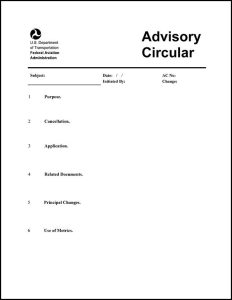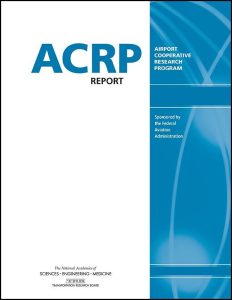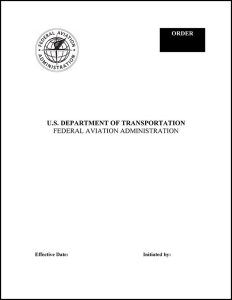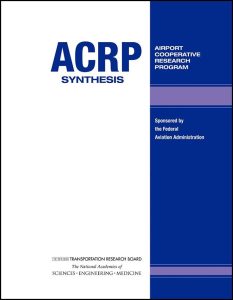To narrow the library of airside resources, use the filter boxes or airport map below or search box above.
Click an item below to expand.
Resources Matching Your Search
2014
This advisory circular (AC) provides guidance to assist airport operators in the procurement of snow and ice control equipment for airport use. The use of this AC is mandatory for all projects funded with federal grant monies through the Airport Improvement Program (AIP) and/or with revenue from the Passenger Facility Charge (PFC) Program. Equipment addressed include high-speed rotary plows, snow plows, material spreaders, runway brooms and carrier vehicles.
2013
ACRP Report 99 provides a step-by-step process for identifying, selecting, and implementing technologies to treat stormwater that has been affected by applied deicing materials. The report addresses the processes for identifying the various drivers for deicer treatment and for evaluating the appropriateness of various treatment technologies to meet an airport's specific needs. The report also provides recommendations for the design, operation, and maintenance of each treatment technology.
2020
ACRP Research Report 14, second edition, explores a wide array of practices designed to provide for the practical, cost-effective control of runoff from aircraft and airfield deicing and anti-icing operations. This second edition has been updated to reflect the latest industry practices. The report will be of particular interest to airport industry practitioners, including airport and aircraft operators, consultants, and regulators.
2020
This advisory circular (AC) provides standards and guidance for designing aircraft deicing facilities. It provides a limited set of, but not the only, acceptable means of meeting the requirements of Part 139. However, the use of this AC is mandatory for all projects funded with federal grant monies through the Airport Improvement Program (AIP) and/or with revenue from the Passenger Facility Charge (PFC) Program.
2019
This handbook provides guidance and sets forth policy and procedures used in the administration of the Airport Improvement Program. This handbook is organized into the following chapters: 1) What Do I Need To Know About This Order?, 2) Who Can Get a Grant?, 3) What Project Can Be Funded?, 4) What AIP Funding Is Available?, 5) How Does the Grant Process Work?, and 6) What Special AIP Programs Are Available? It also contains the following appendices: A) Definitions of Terms Used in the Handbook, B) References and Web Links, C) Prohibited Projects and Unallowable Costs, D) Miscellaneous Projects, E) Planning Projects, F) New Airport Projects, G) Runway Projects, H) Taxiway Projects, I) Apron Projects, J) Airfield Marking, Signage and Lighting Projects, K) Navigational Aid and Weather Reporting Equipment Projects, L) Safety and Security Equipment Projects, M) Other Equipment Projects, N) Terminal Building Projects, O) Other Building Projects, P) Roads and Surface Transportation Projects, Q) Land Projects, R) Noise Compatibility Planning/Projects, S) Environmental Planning/Mitigation Projects, T) Military Airport Program Projects, U) Sponsor Procurement Requirements, V) Revenue Sources for Airport and Airway Trust Fund, W) Competition Plans, Y) Federal Share at Public Land State Airports, and Z) Establishment and Category Upgrade Policy for Instrument Landing Systems.
2015
ACRP Report 123 helps managers, operators, and users of small to large airport facilities prepare for, operate during, and recover from disruptive winter events as well as manage airport user expectations. The guidebook identifies and evaluates best practices in airport airside and landside winter operations, as well as provides suggestions on how to manage overall passenger experience within a framework of safety and efficiency. The guidebook also provides guidelines to airport operators for determining the optimal level of investment necessary to implement an effective program given expected winter conditions and the nature of aviation activity at that particular airport.
2011
ACRP Synthesis 29 addresses the current state of ground-handling practices, focusing on safety measures and training. Issues addressed in the report include ramp safety operations, staff roles and responsibilities, safety training, audit and inspection programs, safety violation programs, and collaborative safety initiatives, such as foreign object debris programs.
2011
ACRP Report 45 provides advice on procedures and technologies designed to reduce the use of aircraft deicing and anti-icing fluids (ADAF) while maintaining safe aircraft operations across the wide range of winter weather conditions found in the United States and Canada. The report is presented as a series of best management practices that are immediately implementable. The report highlights the detailed findings and recommendations of experiments to evaluate holdover time determination systems, spot deicing for aircraft frost removal, and ADAF dilutions. This report will be of direct interest to airport and airline staff responsible for aircraft deicing and anti-icing operations and the mitigation of their environmental impacts.
2012
ACRP Report 81 identifies the relevant factors in defining a winter design storm for use in sizing airport deicing runoff management systems and components. The report also provides a decision support tool for identifying an appropriate winter design storm for an airport-specific project; a review of regulations as they pertain to deicing runoff; and suggestions for target levels of service, including the acceptable level of risk of the designed system not meeting performance standards.
2017
ACRP Research Report 72, second edition, provides a step-by-step process for identifying, evaluating, and selecting methods to monitor stormwater that is subject to runoff containing deicing materials. The report addresses identifying the parameters to be monitored and discusses the appropriateness of various monitoring methods and instrument types to meet an airport's specific needs. The report also provides recommendations for setup, operation, and maintenance of each monitoring method.
2013
TRB conducted a webinar that will feature research conducted by ACRP about environmental planning aspects for deicing materials and the collection and monitoring of storm water management systems. Airport planners and designers face special operational challenges during winter storm events, such as the use of deicing materials for ice and snow removal from aircraft and airfield surfaces while minimizing the environmental impacts of storm water runoff that may contain toxins.
2015
TRB conducted a webinar that featured research conducted by ACRP on safety and financial concerns involving airport winter operations. Webinar presenters discussed best practices and practical applications to help airport stakeholders determine the level of investment in winter operations and safety implications.
TRB Webinar: Winter Operations: Understanding Aircraft Deicers and Their Impact on Stormwater Runoff
2017
TRB conducted a webinar that features research conducted by ACRP that will assist airport operators and environmental managers in understanding the range of potential aircraft deicer treatment technologies and aquatic toxicity testing in order to measure the impact of deicers on stormwater. The webinar focused on the process for selecting a deicer application technology and provided attendees with the information needed to support that process. This webinar also discussed the challenges of testing and interpreting the results of stormwater samples.
2015
ACRP Report 134 describes the unique characteristics of stormwater toxicity testing at airports and provides practical suggestions for developing sound whole effluent toxicity (WET) testing programs in an airport setting. The issue is important to many airports because their environmental permits may contain monitoring requirements for WET testing. The report will be a particularly valuable resource to airport environmental practitioners and environmental regulators wishing to ensure that monitoring samples accurately reflect field conditions.
2020
TRB hosted a webinar that discussed an adaptive management planning approach for deicing operations at airports based on a best management practices (BMPs) framework. The webinar presenters described five categories of BMPs—aircraft deicing source reduction, airfield pavement deicing source reduction, deicing stormwater runoff containment and collection, deicing runoff treatment and recycling, and deicing runoff system components. The webinar featured research from ACRP Research Report 14: Deicing Planning Guidelines and Practices for Stormwater Management Systems, second edition.




